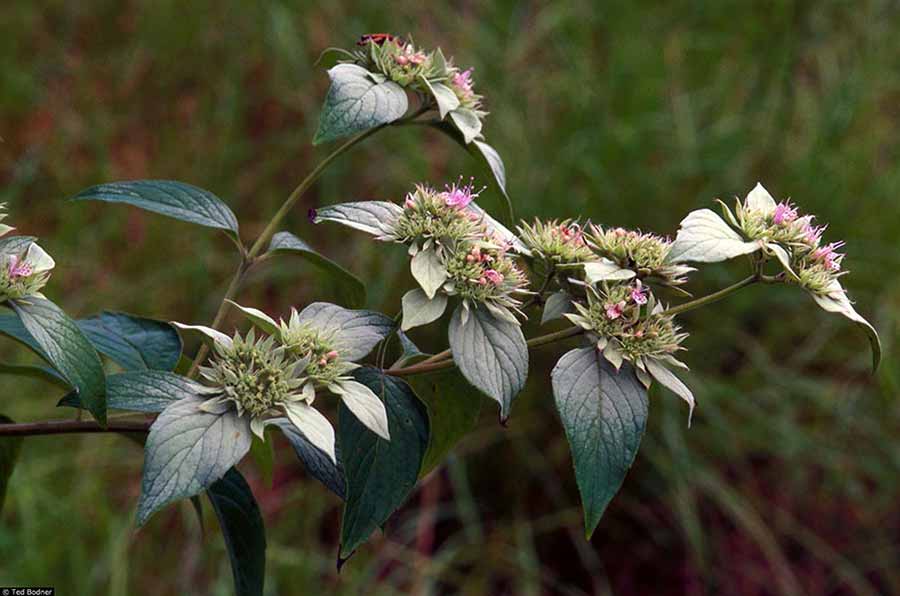Hoary Mountain-mint

Introduction
This chapter provides a review of progress toward protection and recovery of Hoary Mountain-mint in Ontario from 2007 to 2015.
Species information
Hoary Mountain-mint (Pycnanthemum incanum) is a perennial herbaceous plant that grows up to one metre in height. The oblong leaves have a strong mint fragrance and are covered with fine white hairs on both surfaces; leaf arrangement on the stems is opposite. Leaves at the top of the plant are green on the upper surface and white below; the lower leaves are white on both surfaces. Dense clusters of small, white, purple-spotted flowers bloom from mid to late summer at the stem ends and in the leaf axils (the area between the upper side of a leaf and the stem that supports it). The stems of this plant are also covered in fine hairs. The plant reproduces by rhizomes (underground stems) or seeds.
Canada-wide, Hoary Mountain-mint occurs only in Ontario, where the species has been documented at three bluff sites between Hamilton and Burlington. The species mostly occurs on steep slopes in dry, sunny openings surrounded by deciduous woods. These openings tend to be warmer due to greater sun exposure than the surrounding shaded areas.
Hoary Mountain-mint faces several threats to its survival and recovery including plant succession, fire suppression, invasive species and slope erosion. Plant succession is the process by which gradual changes in the local plant community take place over time, for example, shrubs and trees begin to fill in an open abandoned field. If woody vegetation becomes denser in an area where Hoary Mountain-mint is growing, the increase in shaded areas may suppress the growth and spread of this endangered species. Natural forest fires, that helped maintain habitat for the species by creating the open sunny areas it requires, have been suppressed as the area in the vicinity of where the species occurs has become more developed. Invasive species such as Common Buckthorn (Rhamnus cathartica), Tartarian Honeysuckle (Lonicera tatarica) and Garlic Mustard (Alliaria petiolata) can alter and degrade habitat. Erosion of the steep slopes where Hoary Mountain-mint tends to grow can result in loss of habitat and plants at these sites.
The survival and recovery of Hoary Mountain-mint in Ontario is influenced by other factors as well. The species is at the northern limit of its range here, with less than 1,000 plants occurring in the province. Limited genetic diversity may affect the species' ability to adapt to new diseases and environmental threats such as climate change.
Hoary Mountain-mint is listed as endangered at both the provincial (Species at Risk in Ontario List) and federal (Schedule 1 under the Species at Risk Act) levels. Globally, it is considered to be secure.
Provincial status
Prior to the Endangered Species Act, 2007 (ESA or "the Act"), the Committee on the Status of Species at Risk in Ontario (COSSARO) assessed Hoary Mountain-mint as endangered and it was regulated under the previous Endangered Species Act in 1994. Hoary Mountain-mint has retained its status as endangered under the ESA. In future assessments, COSSARO may consider information gained through protection and recovery actions regarding the species' threats and trends in population and distribution.
Species and habitat protection
Protecting Hoary Mountain-mint and its habitat are key components in the implementation of the ESA, and continue to be government-led actions, as identified in the government response statement. As a species that was regulated under the previous Endangered Species Act, Hoary Mountain-mint has received species and habitat protection since 1994. The ESA protects the species from being killed, harmed, harassed, captured or taken and protects its habitat from being damaged or destroyed. Habitat protection under the ESA for Hoary Mountain-mint is based on the general habitat definition in the Act, as the ESA does not require a habitat regulation to be developed for transition species
As a species that was regulated under the previous Endangered Species Act, Hoary Mountain-minthas received species and habitat protection since 1994. The species is currently protected from being killed, harmed, harassed, captured or taken under the ESA.
In addition, the habitat of Hoary Mountain-mint is currently protected from being damaged or destroyed based on the general habitat definition in the ESA.
Recovery strategy
A recovery strategy for Hoary Mountain-mint was completed on February 18, 2011, which was in advance of the date required by the ESA. Recovery strategies are advice to government and represent the best available scientific knowledge. The strategy identified Hoary Mountain-mint habitat needs and the threats that it faces, while recommending objectives and approaches for protecting and recovering the species. The recovery strategy also included recommendations on the areas of habitat to be considered in the development of a habitat regulation.
Government response statement
The Ministry of Natural Resources and Forestry ("the Ministry") published the government response statement (GRS) for Hoary Mountain-mint on November 18, 2011, which was within the timeframe required by the ESA. The GRS is government policy that contains the Government of Ontario’s goal for the recovery of Hoary Mountain-mint.
To help achieve this goal, the government leads and supports recovery actions identified in the GRS. Common actions for the government to lead as it works toward achieving a species' recovery goal are provided in section 2.5 of the Species at Risk Program Status (2008-2015). The GRS for Hoary Mountain-mint also lists three actions the Ministry supports others to undertake for the species. These government-supported actions fall under the objectives identified in the GRS, which are:
- Implement measures to protect and improve habitat for Hoary Mountain-mint; and
- Improve knowledge of the abundance and population dynamics of Hoary Mountain-mint and factors that may be limiting their viability within Ontario.
Recovery Goal
The government’s goal for the recovery of Hoary Mountain-mint is to ensure the long term survival of existing Ontario populations.
Supporting our partners
Supporting partners to undertake activities to protect and recover Hoary Mountain-mint through the Species at Risk Stewardship Fund as well as through permits and their associated conditions, is an important government-led action identified in the GRS for the species. To date, no authorizations or regulatory provisions have been issued or registered for this species. Through the Species at Risk Stewardship Fund, the Ministry has supported six projects ($191,487) designed to contribute to the protection and recovery of Hoary Mountain-mint. One multi-year project ($16,681) focused exclusively on Hoary Mountain-mint; the partner reported they were successful in securing support ($16,681) from other sources. The other five projects ($174,806) focused on multiple species at risk, including Hoary Mountain-mint; for these projects, all partners obtained support ($194,668) from other sources. These amounts include additional funding and in-kind support in the form of time and expertise provided by volunteers.
Ontario’s Invasive Species Act
The GRS for Hoary Mountain-mint indicates that invasive species pose a threat to the survival and recovery of the species in Ontario. The provincial Invasive Species Act, 2015, came into force on November 3, 2016 and provides an enabling framework to support the prevention, detection and control of invasive species in Ontario. This framework may support actions to reduce the threats of invasive species on native and at-risk species, including Hoary Mountain-mint.
For the project that focused exclusively on Hoary Mountain-mint, stewardship partners reported that the province’s funding support helped involve five individuals who volunteered 16 hours of their time toward protection and recovery activities that included enhancing 1.09 hectares of habitat for the species. Among the other stewardship partners, a total of 156 individuals volunteered 2,623 hours of their time toward protection and recovery activities for multiple species at risk, which has an estimated value of $96,260.
The remainder of this section highlights projects conducted by partners that were supported through the Species at Risk Stewardship Fund for Ontario and their corresponding government-supported actions.
A group of stewardship partners received funding through the Species at Risk Stewardship Fund two years in a row to undertake tallgrass prairie habitat restoration activities where numerous species at risk occur, including Hoary Mountain-mint. During the first project (2009-2010), invasive woody vegetation was removed from the top of a slope at Woodland Cemetery to prepare additional suitable habitat for Hoary Mountain-mint. The project supports the GRS by implementing management actions to improve Hoary Mountain-mint habitat, including removal of invasive woody vegetation, and monitoring plant populations. The project also supports the GRS action of providing information to increase landowner awareness and promote protection and recovery of prairie species, including Hoary Mountain-mint. This was done by developing and installing interpretive signage at the site to increase awareness and promote the protection and recovery of species at risk.
For the 2010-2011 project, more woody vegetation was removed from steeply sloping areas in the cemetery and annual oats were sown to stabilize the terrain. It was observed that the Hoary Mountain-mint plants documented the year before were persisting in the open slope area. In addition, a new sub-population of fifteen seedlings was discovered in an area that had been cleared in 2008. This project supports the GRS by implementing actions to improve habitat through invasive species removal, and evaluating the effectiveness of these activities.
A Habitat Restoration Success Story
From 2008 to 2011 the Ministry collaborated with Hamilton Wentworth Stewardship Council to restore Hoary Mountain-mint habitat at Woodland Cemetery in the City of Hamilton. The species had been observed there in the past, but more recently was considered to be extirpated from the site. Restoration work included removing invasive species and conducting carefully-timed prescribed burns to create more open conditions and restore patches of oak savannah where the species previously occurred. As a result of this work, Hoary Mountain-mint was subsequently observed growing at the site. The Ministry monitored the site again in 2012 and determined that the population of Hoary Mountain-mint is stable and likely increasing. In 2013, the City of Hamilton received funding through the Species at Risk Stewardship Fund to continue this work.
Over the past three years, the City of Hamilton has undertaken habitat enhancement work involving multiple sites along the slope area of Woodland Cemetery. The multi-year project supports the GRS by implementing management actions to improve Hoary Mountain-mint habitat. Actions have included invasive plant species removal, prescribed burns and a site cleanup. Ninety percent of the invasive plants have been removed to maintain sunny openings where Hoary Mountain-mint can grow. The project supported other GRS actions as well, including monitoring the plant population, developing public outreach materials and erecting education signage on the site to increase awareness and promote protection and recovery of Hoary Mountain-mint.
Species at Risk Stewardship Fund
-
 $16,681
$16,681for Hoary Mountain-mint exclusively
-
 $174,806
$174,806for multi-species projects that included Hoary Mountain-mint
-
 $211,349
$211,349in additional funding and in-kind support
-
 6
6projects included the Hoary Mountain-mint
-
 161
161volunteers
-
 2,639
2,639volunteer hours
-
 1
1hectare of habitat enhanced
Occurrences of Hoary Mountain-mint in Ontario
Natural Heritage Information Centre (NHIC)
There is one population
One sub-population at Woodland Cemetery appeared to have no stems during surveys in 2008 and was ultimately determined to be lost due to slope erosion. However, a new sub-population has been discovered in Woodland Cemetery since 2008, when the species became protected under the ESA. In 2010, this new sub-population consisted of 15 Hoary Mountain-mint seedlings and appears to have become established from an existing seed bank following site restoration that began in the fall of 2008. Additionally, there are three other sub-populations that occur at Woodland Cemetery.
Since 2008, the Ministry has received approximately 21 records of Hoary Mountain-mint. These records are based on observations made between 1873 and 2011. It is possible that there are observations of Hoary Mountain-mint that have not been submitted to the Ministry. Encouraging the submission of observations of Hoary Mountain-mint to the Ministry is included in the GRS as a government-led action.
Everyone is encouraged, or may be required by an authorization or approval, to submit observations of the Hoary Mountain-mint, as well as every other species at risk, to the Ministry’s Natural Heritage Information Centre for incorporation into the provincial record of observations.
21 observations of this species were submitted to the NHIC since 2008
Summary of progress toward meeting the recovery goal
Summary of progress
Progress has been made toward all of the government-led recovery objectives and all of the associated actions that are identified in the GRS for Hoary Mountain-mint. As indicated in this chapter, the Government of Ontario has directly undertaken actions to:
- Protect the species and its habitat through the ESA;
- Encourage submission of Hoary Mountain-mint data to the Natural Heritage Information Centre; and
- Support partners to undertake activities to protect and recover the species.
- Establish and communicate annual priority actions for support (section 3.1);
- Educate other agencies and planning authorities on the requirement to consider the protection of the species and its habitat (sections 3.3 and 4.4); and
- Undertake communications and outreach to increase public awareness of species at risk in Ontario (section 4.3).
Under the government-supported objective to implement measures to protect and improve the habitat for Hoary Mountain-mint, considerable progress has been made toward both of the GRS actions:
- Implement and evaluate the effectiveness of management actions to improve Hoary Mountain-mint habitat and surrounding areas which may include prescribed burning and the removal of invasive species (Action No.1; High Priority); and
- Develop and provide information to landowners to increase awareness and promote protection and recovery of Hoary Mountain-mint (Action No.2).
These actions were implemented through several projects supported by the Species at Risk Stewardship Fund and MNRF staff. Habitat enhancement activities, such as removal of invasive woody plants and conducting of prescribed burns, were completed at Woodland Cemetery in the City of Hamilton and Willow Point in Burlington. Information for local landowners about prairie species, including Hoary Mountain-mint, was provided through the development of outreach materials and interpretive signage for installation at the cemetery property.
Under the objective to improve knowledge of the abundance and population dynamics of Hoary Mountain-mint and factors that may be limiting their viability within Ontario progress has been made toward the GRS action:
- Monitor populations periodically to determine any changes in population abundance and evaluate the extent of threats (Action No. 3).
This action was implemented through a project supported by the Species at Risk Stewardship Fund. At the project site, the effectiveness of habitat restoration activities was evaluated by monitoring Hoary Mountain-mint sub-populations. During the monitoring, a new sub-population of Hoary Mountain-mint was discovered nearby in an area where restoration work had been conducted several years before.
The recovery goal for Hoary Mountain-mint is to ensure the long-term survival of existing populations in Ontario. Several government-led and government-supported GRS actions discussed above have made progress toward meeting this goal. The species is considered extant and the identification of a new sub-population through habitat restoration contributes to its long-term survival and resiliency. However, monitoring of the species' sub-populations will need to continue to evaluate and manage threats (e.g., invasive species, succession, erosion), and enable further progress toward the GRS recovery goal.
Recommendations
As stated in the GRS, the review of progress toward protecting and recovering Hoary Mountain-mint can be used to help identify whether adjustments are needed to achieve the protection and recovery of the species. Based on the information reviewed and progress to-date, the overall direction provided in the GRS for Hoary Mountain-mint should continue to guide protection and recovery actions for the species, particularly for actions identified as high priority in the GRS as high priority. Relative to actions that have received a high level of support, the following actions have received support to a lesser degree; this may be considered in decisions regarding the protection and recovery of Hoary Mountain-mint:
- Management actions to improve Hoary Mountain-mint habitat have been implemented, such as removal of invasive plant species and prescribed burns. In addition to continuing to implement management actions, work is now required to evaluate the effectiveness of the actions (Action No. 1; High Priority).
Although progress has been made toward monitoring periodically to determine any changes in population abundance and evaluate the extent of threats, additional monitoring is recommended to determine the status of the Willow Point population of Hoary Mountain-mint, where numbers of plants has fluctuated (Action No. 3).
Moving forward, protecting and recovering Hoary Mountain-mint will continue to be a shared responsibility that will require the involvement of many individuals, organizations and communities. Financial support for the implementation of actions may be available through the Species at Risk Stewardship Fund or the Species at Risk Research Fund for Ontario. The Ministry can also advise if any authorizations under the ESA or other legislation may be required to undertake a project. By working together, progress can continue to be made toward protecting and recovering Hoary Mountain-mint in Ontario.
Summary of progress toward the protection and recovery of Hoary Mountain-mint in Ontario (2007 to 2015)
Provincial status:
- Hoary Mountain-mint is classified as endangered under the Endangered Species Act, 2007 (ESA). Hoary Mountain-mint was also listed under the previous Endangered Species Act and has retained the same status since transition to the ESA. Hoary Mountain-mint has received species and habitat protection since 1994.
Species-specific documents and guidance published by the government:
- Recovery Strategy for Hoary Mountain-mint (Pycnanthemum incanum) (2011)
- Hoary Mountain-mint: Ontario Government Response Statement (2011)
Government-supported stewardship projects:
- Through the Species at Risk Stewardship Fund the Ministry of Natural Resources and Forestry ("the Ministry") has enabled its stewardship partners to conduct six projects ($191,487) that have supported the protection and recovery of Hoary Mountain-mint. One project ($16,681) focused exclusively on Hoary Mountain-mint, while the other five projects ($174,806) focused on multiple species at risk, including Hoary Mountain-mint.
- The Ministry’s support helped its stewardship partners to involve 161 individuals who volunteered 2,639 hours of their time toward protection and recovery activities for species at risk, including Hoary Mountain-mint. The estimated value of these voluntary contributions, as well as additional funding and in-kind support, is $211,349.
- Stewardship partners reported that, through one of the projects, 1.09 hectares of habitat were enhanced for Hoary Mountain-mint and other species at risk that inhabit the same ecosystem.
Occurrences and distribution:
- There is one population of Hoary Mountain Mint in the Burlington/Hamilton area. This population is considered to be extant (i.e., observed within the last 20 years) and is composed of multiple sub-populations at two locations: Willow Point and Woodland Cemetery. A third sub-population at Carroll’s Point is considered to be extirpated. In 2010, a new sub-population consisting of 15 Hoary Mountain-mint seedlings was discovered that appeared to have germinated from an existing seed bank following site restoration work. There are three more sub-populations that also occur within the cemetery property. The number of stems in the sub-population at Willow Point has fluctuated since its discovery, but overall has increased since 2000.
Related information
- Categorizing and Protecting Habitat under the Endangered Species Act
- Natural Heritage Information Centre
- Ontario’s Endangered Species Act
- Ontario’s Endangered Species Act Regulation 242/08
- Ontario Recovery Strategy and Government Response Statement for Hoary Mountain-mint
- Policy Guidance on Harm and Harass under the Endangered Species Act
- Species at Risk in Ontario List
- Species at Risk Stewardship Fund
References
COSEWIC. 2011.COSEWIC status appraisal summary on the Hoary Mountain-mint Pycnanthemum incanum in Canada. Committee on the Status of Endangered Wildlife in Canada. Ottawa. xiii pp
Footnotes
- footnote[1] Back to paragraph A "transition species" is a species listed under schedule 1, 3, or 4 of the ESA that has not changed in status since June 2008.